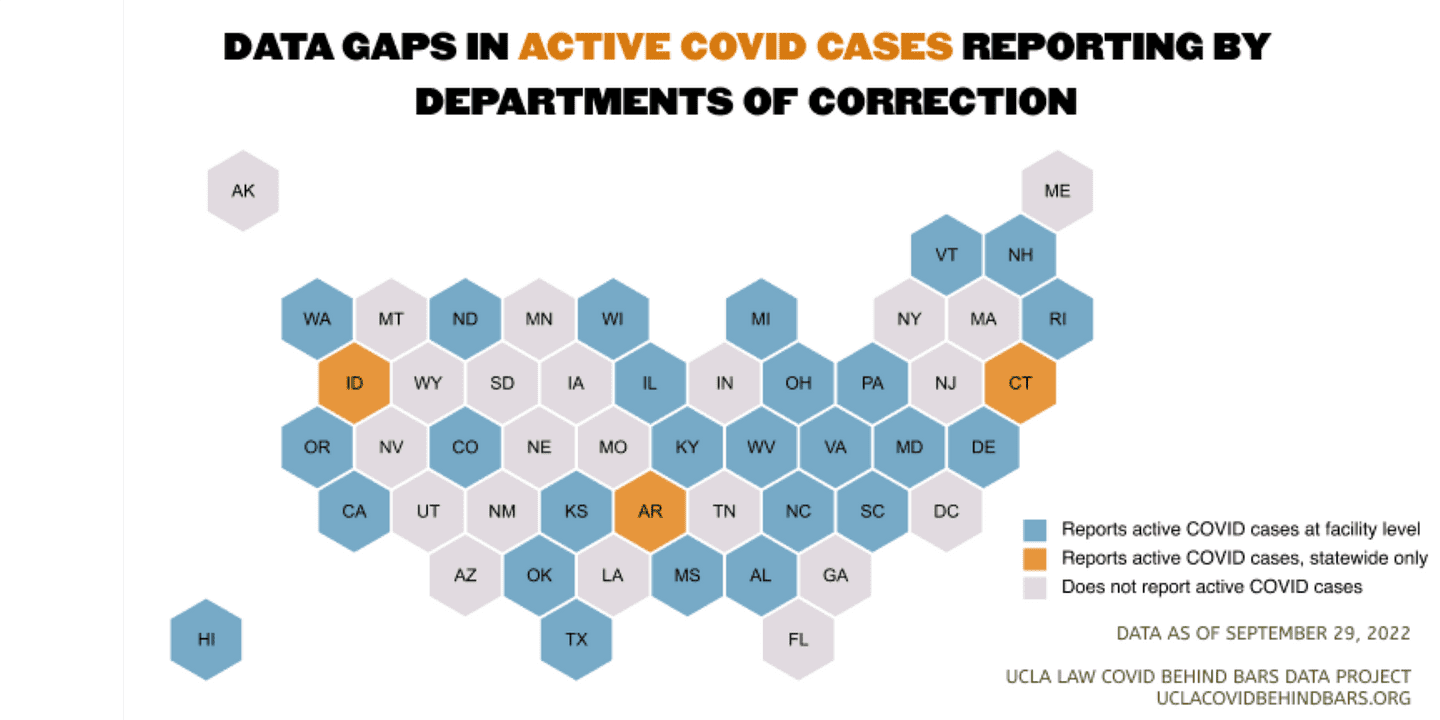October 18th, 2022 • Baji Tumendemberel and Bennett Stein
21 States and D.C. Have Stopped Reporting Active COVID Cases in Prisons, Despite Active Community Outbreaks
As COVID rates in some places have increased in recent months, we know increasingly less about infections behind bars. Given the ongoing outbreaks in surrounding communities and nearby federal carceral facilities, we might expect to see increased numbers in state prisons too. However, twenty-one states and D.C. no longer report the number of active COVID cases in their prisons, meaning the public no longer knows whether there are outbreaks in these places of confinement and obscurity. The absence of data impedes the work of policymakers, journalists, and advocates while depriving people living and working in carceral facilities, and their families, of the information necessary to make decisions to protect their own health.
We can look to the state of Indiana as an example. Since the BA.2 variant arrived in Spring 2022, many states reported a sustained increase in weekly COVID cases in the community. Indiana was no exception. The rolling seven-day average of COVID cases hovered under 200 per day in April. By June, this figure had risen to over 2,000 cases per day. Through much of September 2022, COVID rates remained high in Indiana (nearly 2,000 cases were reported on September 21).
We only know this information due to regular reporting of cases, hospitalizations, and deaths in Indiana’s population. However, for those in its prisons, the state has gone dark. Since April 18, 2022, Indiana has ceased all reporting of COVID data from its carceral facilities, meaning we have no way to track the impacts of novel variants and weakening mitigation measures.
Consequently, those who seek to make data-informed decisions concerning COVID and public health, report the news, or advocate on issues in their communities must do so without the full picture. As public health officials monitor new variants and consider interventions to ward off a fall or winter surge, they – and the rest of us – will have no active information from D.C. and 21 state prisons systems. This gap in the record also means that future policymakers and researchers will struggle to include incarcerated persons in their review of the COVID pandemic, hindering both insight and action.

Since March 2021, the UCLA COVID Behind Bars Data Project has conducted regular transparency evaluations of all 50 state prison systems, the Bureau of Prisons (BOP), the District of Columbia (D.C.) Department of Corrections, and ICE detention centers. Each carceral agency is assessed on both (1) the type of data it reports and (2) the quality of the data itself. These metrics are then translated into letter grades in our Data Reporting and Quality Scorecard.
We again updated the Scorecard in June 2022 and September 2022. As we reviewed agency reporting, we identified several prison systems where COVID reporting webpages were still live, but the data reported had not been updated for many months. Beginning with the June update, we did not award points if the agency had not updated reporting in at least two months.
Since the initial Omicron surge, large COVID outbreaks have continued to hit prisons. Every week, we continue to identify outbreaks in many of those carceral institutions across the country that continue to report active cases. At the same time, our scorecard update makes clear that carceral agencies are rapidly reducing the information they share publicly and rolling back basic transparency measures that were put in place earlier in the pandemic. Rather than reverting to the longstanding, closed-off status quo, carceral agencies should bolster their public health reporting programs to prepare for possible COVID surges in the future, respond to novel challenges such as the monkeypox outbreak, and share core public health information. When a state stops or reduces reporting, our team (recently led by Ritika Bhattacharya) follows up directly with the prison agency to understand why they have limited reporting and we advocate for increased data transparency.
When we first released our scorecards, 75% of carceral agencies received an F. With the September 2022 update, only five carceral agencies (9%, California, Maryland, Pennsylvania, West Virginia, and Washington) received a grade higher than an F.
Key changes:
- Since January 2022, the scorecard now reflects that the prison systems in Alaska, Indiana, Iowa, Louisiana, Missouri, Nebraska, New Mexico, South Dakota, Utah, and Wyoming have stopped reporting any COVID data. Additionally, Minnesota stopped reporting resident and staff cases.
- Idaho, Michigan, New Hampshire, and Ohio prison systems have ceased reporting on carceral staff cases.
- Idaho, Kansas, New Hampshire, North Carolina, and West Virginia have stopped reporting vaccination data.
- California, Washington, and Wisconsin have added or updated data on booster shots.
- Additionally, Alabama, Delaware, Maryland, and Rhode Island prison systems have decreased the frequency of their reporting. We will continue to monitor their reporting practices.
To learn more about our grading mechanism, please refer to the “About the Metrics” section of our June 2021 update.
next post
October 20th, 2022 • Josephine Wang
Reflecting on the Power of Grassroots Activism During the Pandemic
Grassroots team volunteer-turned-leader reflects on the work completed by the team over the course of the pandemic.